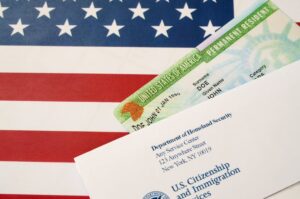
When immigrating to the United States, there are many steps and forms you will need to fill out for your application. U.S. Citizenship and immigration services are very intricate, with time limits, expensive filing fees, and long waiting lists. Making sure that you are filing the correct immigration form, at the correct times, and that they are filled out properly with all needed evidence included, can make your immigration process easier and less expensive.
If you are looking to become a permanent resident of the United States, the Law Office of Jason A. Dennis is ready to help you. As one of the top immigration attorneys in New York City, New York, Jason A. Dennis is a dedicated immigration attorney.
Applying for Permanent Residence
To become a pediment resident of the United States of America, you will need to apply for a green card. The application for permanent residence is form I-485: Application to Register Permanent Residence or Adjust Status. This form is used to:
- Become a permanent resident through your job
- Become a permanent resident through aslyee status, for those who have been granted asylum
- Become a permanent resident through refugee status
- Apply for an immediate relative or preferred relative to become a permanent resident
In plain terms, this is the form you will file if you have gotten married and need a green card, if you are a permanent resident and are applying for permanent residence for family members, or to change your status as a refugee or asylum seeker to the status of permanent residence.
What Should be Included With an I-485 Form?
The included paperwork and evidence depend on which reason you are filing form I-485. The most common reason for filing form I-485 is for a green card after a marriage to a US citizen. If you are filing for permanent residence after getting married, you will need to include 2 passport-sized photos of yourself, government issues ID from your home country (such as your passport), your birth certificate, your inspection, and admission papers from the Port of Entry at which you entered the United States, as well as several other forms.
These forms can include but are not limited to, Form I-130, I-864, I-601, I-212, I-612, I-508, I-566, and I-485 Supplement A. If you do not have photo identification from your home country or a copy of your birth certificate, there are alternative options available that may apply to you and your situation.
This list differs depending on how you are planning on sponsoring your green card. For example, persons filing employment-based green card applications have to file an I-140 form as well, which is the Immigrant Petition for Alien Worker form. This is called concurrent filing, as you are filing a petition to work in the United States as well as a petition to become a permanent resident of the United States at the same time.
Everyone’s 1-485 application is different, and it’s important to seek legal advice or hire an immigration attorney before filing any paperwork. Missed forms, evidence, and deadlines are the biggest reasons why many people’s immigration and green card applications are denied. With an attorney on your side, you can guarantee your submitted packet will include all required supporting documentation and forms, as well as that it will be turned in on time and your filing fees paid. You also avoid the risk of accidentally paying to file the wrong paperwork, as filing fees are 100% un-refundable.
How Much Does it Cost to File Form I-485?
The filing fee for your I-485 application is $1,140 for all filers, except for those who were admitted into the United States on refugee status. If you are a refugee in the United States, you are able to file Form I-485 for free. On top of this charge, for filers between the ages of 14 to 78 years old, there is also an $85 biometrics fee that must be paid during your biometrics appointment.
While there are no available fee reductions for form i-485, some filers may be eligible for a fee waiver, that would completely waive the filing fee for your I-485 application. This fee waiver, form I-912, has its own set of qualifications and stipulations. Your fee waiver will only be granted if you can demonstrate to USCIS that you are either at or below 150% of the poverty line, or you have other financial hardships. These financial hardships can vary, from medical bills to unemployment, to disability to making you unable to work.
What is an Adjustment of Status?
Form I-485 can also be used as an application for adjustment of immigration status. This is so that refugees or asylum seekers who are located in the United States are able to join the green card application process without a sponsor, as well as students in the United States on nonimmigrant visas are able to apply for permanent residence as well.
In job-related green card applications and family-related green card applications, your job or family would sponsor your arrival in the United States. If you are a refugee or asylum seeker, there is no one to sponsor your immigration journey and this form allows you to apply for an adjustment of your immigration status from its current state to permanent resident.
This adjustment of status does not apply to everyone. For example, if you are in the United States on a tourist visa, you do not have any kind of immigration status in the United States and would be starting from scratch if you wanted to apply for permanent residence, rather than adjusting a status you do not have.
Temporary visas, such as a temporary work visa, are also tricky because those who have been awarded these visas will most likely have to leave the United States before their processing time has been completed. You must be in possession of a valid visa in order to qualify as adjustment of status applicants.
How Long Does it Take to be Granted Permanent Residence Status?
Once you file your application and petition, you will be given a priority date. This can be thought of as your place holder in the line for a green card. Applications are reviewed and either approved or denied in the order they were filed, so at any given time there can be dozens, hundreds, or even thousands of people ahead of you in line to have their petitions reviewed.
While the line behind you will continue to grow, the line in front of you will, thankfully, always slowly become smaller. Permanent immigration to the United States, however, is not a quick process, and the time you can expect to wait depends on how/why you filed your application. Spouses, widow(er)s, parents, or children of US citizens can expect to wait around 10-17 months at any given time to finish their green card process, while most other filers wait between 2-3 years. Some people can wait up to a decade, such as the adult children of green card holders from Mexico or the Philippines.
Get Help From an Attorney Today
While fear of price tags and long waits can cause people to hesitate, the sooner you file your immigration paperwork the sooner you become a permanent resident of the United States. Waiting only makes your wait longer. If you’re ready to get started on your application for permanent residence in the US, call the Law Office of Jason A. Dennis today.
Through an initial consultation, we will look over your case with you and help you decide the best way and time to file. Your future is waiting on you, the time for hesitation is over. Schedule your free consultation with a New York immigration lawyer today.

